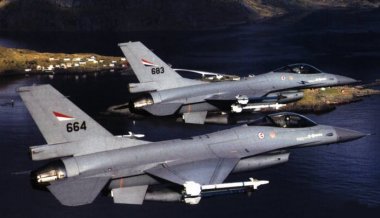The Air Force became an independent service in November 1944. Air power is essential for the Total Defence Concept and the establishment and maintenance of air superiority in a time of crisis or war. The Air Force is characterised by a rapid reaction time and highly mobility, and is thus an effective and flexible tool for crisis management.
The main task is to report and exercise air operation against any air, sea, or land based invasion. The service is to contribute to reception off allied support, and to lead and participate in multinational forces. The Air Force also supports the operations of the Coast Guard and the Search and Rescue Services.
The Air Force counts 7 air stations, 2 CRC's (Control and Reporting Centers), 2 educational centers, 10 squadrons and 2 surface-to-air missile batallions. The Air Force has 57 F-16 fighters, 6 NASAMS (Norwegian Advanced Surface to Air Missile System) batteries, 12 Sea King search and rescue choppers, 6 P-3 Orion maritime patrol planes, 6 Hercules C-130 transport planes, 6 Lynx coastguard choppers, 18 Bell 412 sp choppers and 3 DA-20 Jet falcon planes. Each air station has an air wing and a logistics organization. The air wing runs the operative activity - the heart of the Air Force. The stations and the logistics organizations offer infrastructure and support to the air wings so they can perform their operative tasks.
In peacetime the Air Force consists of approximately 3200 employees, with about 2100 are officers and civilians and 1100 enlisted staff. After mobilisation the Air Force concists of approximately 17,500 soldiers.
Updated: 09.06.2005

 The Royal
Norwegian Air Force
The Royal
Norwegian Air Force